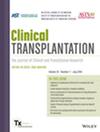Impact of Restrictive Cardiac Allograft Physiology on Heart Re-Transplantation Outcomes
Abstract
Background
Heart re-transplantation (re-HT) is the last treatment option for end-stage graft failure, with cases due to severe cardiac allograft vasculopathy (CAV) showing a better prognosis compared to other indications. However, the effects of restrictive cardiac allograft physiology (RCP), classified as severe CAV, on re-HT outcomes remain unclear.
Methods
We assessed patients with severe CAV who underwent re-HT between 2010 and 2024. RCP was defined as symptomatic heart failure with restrictive echocardiographic values (E-to-A velocity ratio >2 and deceleration time <150 ms) or hemodynamic values (mean right atrial pressure >12 mmHg, pulmonary capillary wedge pressure >25 mmHg, and cardiac index <2.0 L/min/m2). The primary outcome was death or third re-HT.
Results
We included 86 patients; 34 patients were complicated with RCP and 52 patients were without RCP. During the follow-up period, two patients underwent a third re-HT, and 16 died. The most frequent cause of death among those with and without RCP was malignancy and cardiovascular death, respectively. The probability of survival from all-cause death or third re-HT was significantly worse for those with RCP than for those without RCP (p = 0.021). Additionally, RCP was independently associated with an increased risk of death or third re-HT (hazard ratio: 3.36; 95% confidence interval: 1.16–9.75; p = 0.026).
Conclusions
Among patients with severe CAV, those with RCP appear to have a worse prognosis after re-HT compared to those without RCP. This finding might be considered in the candidate selection for re-HT.

 求助内容:
求助内容: 应助结果提醒方式:
应助结果提醒方式:


